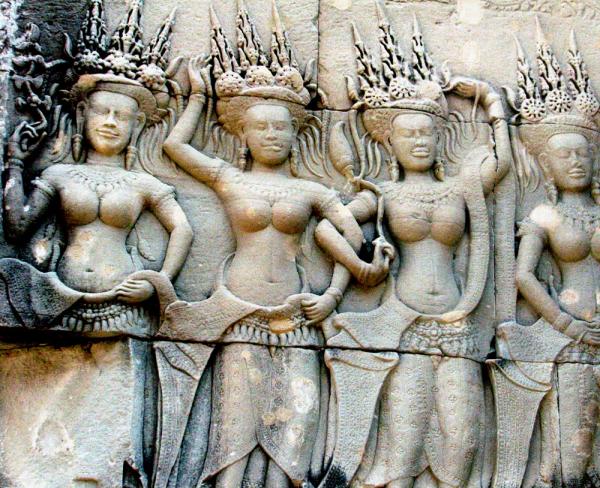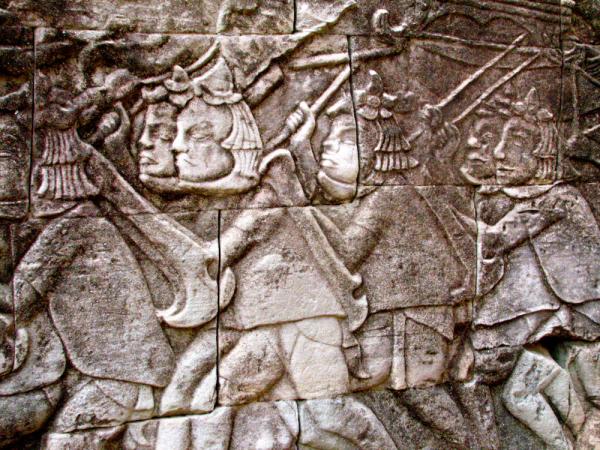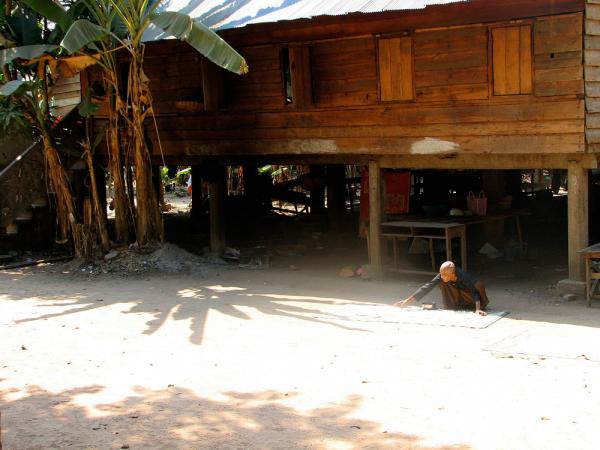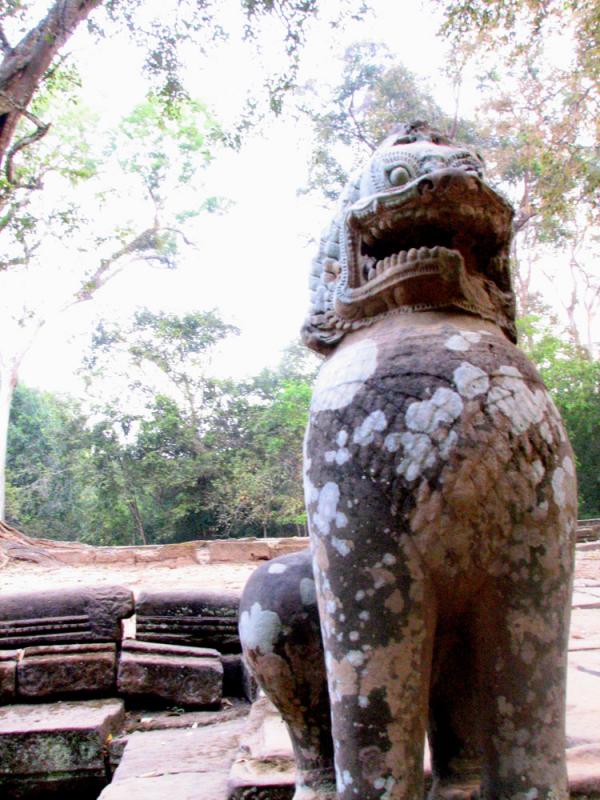
Photos: The Riddle of Ancient Angkor
The story of ancient Angkor

The air is so thick with heat that it makes me feel light-headed and dizzy. Strange half- smiling faces stare back from the walls, enticing me to follow...
As I walk through the ancient city of Angkor in Cambodia, the figures cut into the stone walls, like the land itself, seem to hold their breath waiting in anticipation for the monsoon rains. Losing myself in this sprawl of ruins gone to seed, it is easy enough to imagine being transported back in time. With a little imagination ancient Angkor, the Khmer Empire's seat of power almost 10,000 years ago, comes alive like a strong breeze suddenly whipping up dust in the still and pensive air.
The Khmer Empire

The people who ruled this ancient city were called the Khmer. Their civilization began roughly around A.D. 802 when a figure named Jayavarman II declared himself universal "god king."
Angkor's glory days extended for over 800 years until the year 1431 when the city was sacked by invaders from the kingdom of Ayuthaya, located in what is now Thailand.
Lasting from the 9th to the 15th centuries the Khmer empire once dominated Southeast Asia from Myanmar (Burma) in the west to Vietnam in the east. At its pinnacle its capital, Angkor, was the most expansive urban complex of the preindustrial world. Even by today's standards Angkor was huge, sprawling across an area the size of New York's five boroughs. It was home to over 750,000 people.
City of the divine

As self appointed "god kings" and emperors of Hinduism, the rulers of Angkor built elaborate temples in homage to themselves and their mythical pantheon of Hindu gods.
Temple shrines like this one, sculpted in the symbolic shape of a rising lotus blossom, were just one of thousands the Khmer erected throughout Angkor during a medieval building spree that rivaled that of the Egyptian pharaohs.
Get the world’s most fascinating discoveries delivered straight to your inbox.
Angkor Wat, the centerpiece of the city's temples, is the world's largest religious monument.
By the 13th and 14th centuries Theravada Buddhism slowly eclipsed Hinduism as the dominant religious and cultural force of Angkor, further adding to the city's cosmopolitan ensemble of religious imagery, this time in the visage of the Buddha smiling down benevolently.
Religious changes

The principles of social equality inherent in Theravada Buddhism may have threatened the power of Angkor's elite, much as Christianity was thought subversive to the power of the ancient Roman Empire. Many scholars believe that this religious shift may have led to civil and political unrest that contributed to the civilization's gradual demise.
Today throughout much of Southeast Asia, including modern day Cambodia, Theravada Buddhism continues to be the dominant religion of the region.
During my travels in Cambodia I met many people including these young monks, eager to practice their English lessons with a native speaker. Cambodians have a well-deserved reputation as some of the friendliest people in the world.
Divining history

The people of Angkor didn't leave a single word to explain their kingdom's collapse. The mystery behind this ancient city remains one of the greatest vanishing acts of all time.
For scholars, the intricate facades and bas-relief carvings adorning the temples offer some of the most visible clues to the people of Angkor. Scenes of everyday activities, such as farmers threshing rice, women giving birth, and men playing board games give us a glimpse into the daily life of the Khmer.
Meanwhile, other reliefs give insight into the spirit world. Figures like these, called apsaras, festoon the temple walls of ancient Angkor capturing the eye and the imagination. For the Khmer these exotic dancing figures were believed to be celestial intermediaries between humans and the gods on Earth.
Trouble in paradise

Interspersed with celestial visions of harmony are scenes that hint at trouble in paradise. Some reliefs in Angkor, such as this one, show spear-bearing warriors marching to battle and conquest.
The kingdoms of Ayuthaya to the west and Champa to the east were constant rivals of Angkor. For centuries the powerful princes of these kingdoms vied for power against one another.
Many scholars believe that such incessant warfare and religious turmoil both contributed to Angkor's demise. By the 16th century sea trade between Southeast Asia and China also shifted the Khmer center of power away from Angkor to the coast, adding further speculations to the reasons behind the kingdom's downfall.
New discoveries

Sidelined by Cambodia's civil war and the brutal and short-lived rule of the Khmer Rouge throughout the 70's and 80's, it was not until the 90's that archaeologists were able to begin revealing the important role of extensively engineered waterworks in both the rise and fall of ancient Angkor.
An ingenious water system composed of canals and dikes relying on the natural inclination of the land may have been the most defining clue to Angkor's greatness. During the dry months water was diverted away from several nearby rivers to water crops, while during the wet monsoon, excess water was channeled away from the city. This control over water the difference between life and death, feast and famine was likely the greatest clue in decades to the mysterious riddle of Angkor's long success as a civilization and subsequent decline.
The riddle of water

Clues that ancient Angkor's elaborate water system began to fail lie hidden beneath the mud.
Archaeologists have found huge portions of an ancient dam used to divert water from the rivers and function as a spillway during times of flood. Over time, managing this massive apparatus to control an increasingly unruly water system probably proved more and more difficult.
Evidence in the form of pollen grain analyses showed that aquatic plants like lotuses flourished in Angkor's large water reservoirs, or barays, but began to be replaced by ferns and other species that prefer marsh or dry land sometime around the 13th century. This suggests to archaeologists that the water had stopped coming. At its zenith something seems to have gone wrong at Angkor that not even its skilled water engineers could solve.
Climatic shifts

Further evidence found in the most unlikely of places helps further decode the puzzle of Angkor.
Contrary to the temperate regions of the world, the tropics have little or no seasonality. This makes finding trees with discernible growth rings difficult in tropical forests. Even more difficult to find are trees that show clear growth rings and have been around as long as ancient Angkor. Despite this some researchers actually found a rare cypress species in the nearby forests old enough to tell this tale.
The story they uncovered was astounding. Sets of constricted growth rings showed that the trees had weathered back-to-back multi-year droughts over extended periods during the 14th and 15th centuries. For Angkor, already plagued by periodic war, religious upheaval, and a faulty water system, extreme weather was likely the last straw. The likely famine unleashed by extreme droughts and super monsoons may help us piece together the last clues to the city's vanishing act.
Lessons from history

At roughly the same time as Angkor's downfall, we know that other parts of the world were being buffeted by unpredictable weather patterns.
This period, called the Little Ice Age, was marked by severe winters and unusually cool summers throughout Europe starting in the 1300's and lasting several centuries. It now seems Southeast Asia was also being affected by climatic catastrophe during this time.
Other famous climatic downfalls in history include the abandonment of Greenland by the Vikings during this period and the fall of Mayan city states done in by complications following a series of severe droughts centuries earlier. A sober warning comes from nature itself: Changing climate was likely the final coup de grâce in the great riddle of Angkor.
